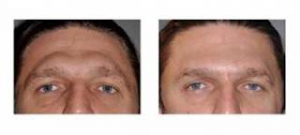
The following are the typical instructions for brow bone reduction:
1. Brow bone reduction is associated with a only a very moderate amount of pain in the first few days after surgery. Narcotic pain medications are prescribed and use them if you need them. In a few days, you may switch to Tylenol or Ibuprofen or alternate between doses with the narcotic medication.
2. There will be a circumferential head wrap placed right after surgery. This is in place to control extreme swelling and does not play a role in maintaining the new position/shape of the brow bones. You may take it on the next day after surgery. If it should get loose or come off during the night, just leave it off. It is not a critical part of brow bone reduction surgery.
3. The sutures in the scalp incision are dissolveable and do not need to be removed. There is no need to apply antibiotic ointment to the incisions as all it will do is make your hair greasy and be hard to shampoo out.
4. Bruising and swelling will develop around the eyes after surgery which is perfectly normal. In some patients the eyes may almost swell shut by the second day after surgery.
5. You may shower and wash your hair 48 hours after surgery. There is no harm in getting your sutures wet with soap and water.
6. Your forehead will feel stiff and may not move normally for up to a month after surgery. It will also feel numb for even longer. This is all normal and as the feeling comes back in the forehead you will experience strange sensations such as shooting pains or itching as the nerves recover.
7. You may wear any type of hat around your forehead whenever you feel comfortable doing so.
8. There are no restrictions on normal daily activities after the surgery. You may do light exercise anytime afterwards that you feel comfortable. But no strenuous exercise that involves bending over for three weeks after surgery.
9. You may drive within several days after the procedure, provided you are off pain medication and can react normally to driving conditions.
10. If any redness, tenderness, or increased swelling develops on the forehead or around the eyes after the first week of surgery, call Dr. Eppley and have your pharmacy number ready.


